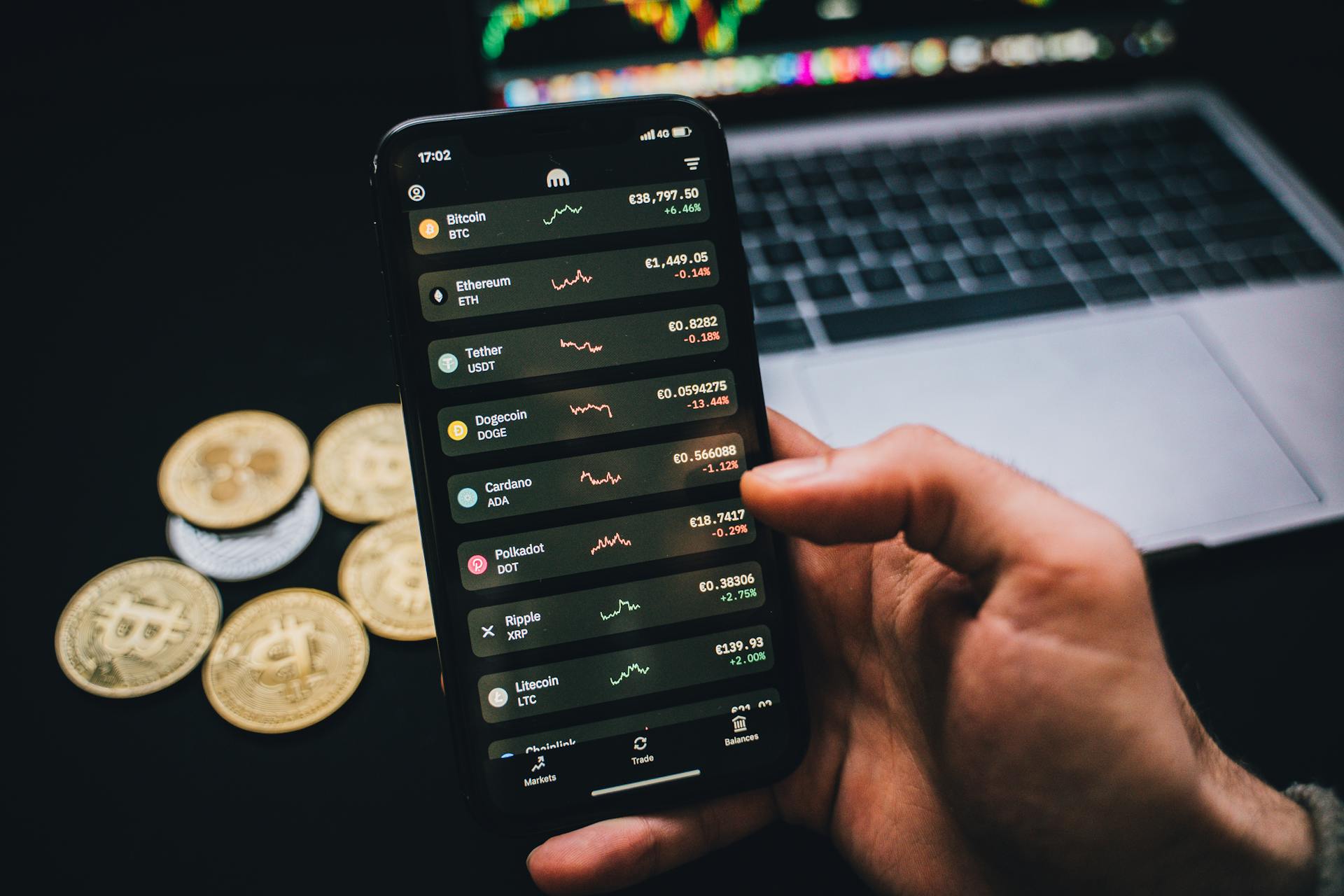
The yen carry trade is a popular strategy among investors, but it can have significant impacts on global markets. In the early 2000s, investors took out yen loans to invest in higher-yielding assets.
One notable example is the 2007 yen carry trade, where investors borrowed yen to buy dollars, which were then used to invest in emerging markets. This led to a surge in demand for dollars, causing the currency to appreciate.
The yen carry trade can have a ripple effect on global markets, influencing exchange rates and asset prices. The 2007 example shows how this can lead to volatility in emerging markets.
Investors should be aware of the risks involved in the yen carry trade, as seen in the 2007 example.
A unique perspective: Global Markets React to the Japanese Yen Carry Trade Unwind
What Is the Yen Carry Trade?
The yen carry trade is a type of investment strategy that involves borrowing Japanese yen at a low interest rate and using the funds to invest in other countries with higher interest rates.
Discover more: Carried Interest
Borrowing yen is attractive because its low interest rate, typically around 0.1-0.5% per annum, makes it a cheap source of funding.
Investors often use this cheap funding to buy assets in countries with higher interest rates, such as the US or Australia.
These higher interest rates can be found in countries with strong economies and low inflation, making them more attractive to investors.
The yen carry trade is a form of arbitrage, where the difference in interest rates between the yen and other currencies is exploited to generate a profit.
Investors use this strategy to profit from the interest rate differential, but it also carries risks, such as changes in currency exchange rates and market volatility.
Recommended read: Low Latency Trading
Understanding the Mechanics
The key to a successful yen carry trade is understanding the mechanics behind it. A trader profits from the difference in interest rates between the two currencies, as long as the exchange rate doesn't change significantly.
Many professional traders use this trade because leverage allows them to magnify the potential gains. With a common leverage factor of 10:1, a trader can potentially earn 10 times the interest rate difference.
The funding currency is the currency exchanged in a carry trade transaction, typically characterized by a low interest rate. Investors borrow the funding currency and go short, while taking long positions in the asset currency, which has a higher interest rate.
The central banks of funding currency countries, such as the Bank of Japan (BOJ), often engage in aggressive monetary stimulus to prop up economic growth, resulting in low interest rates.
What Is Currency?
A currency is a medium of exchange, and in the context of forex trading, it's the unit of account used to trade and invest.
Currencies are often categorized as low-interest-rate or high-interest-rate currencies, with the former typically being more attractive for borrowing and the latter for investing.
The value of a currency can fluctuate based on economic indicators, interest rates, and global events, making it a dynamic market.
A currency's interest rate determines its attractiveness for borrowing or investing, with high-interest-rate currencies offering higher returns but also higher risks.
The Japanese yen is often considered a low-yielding currency, which has made it a popular choice for the currency carry trade strategy.
The Australian dollar and the New Zealand dollar are examples of high-yielding currencies that have been traded against the Japanese yen in the past.
Suggestion: Dollar to Yen Forecast
Mechanics of the Yen Carry Trade
The yen carry trade is a popular forex trading strategy that involves borrowing the Japanese yen, which has a low interest rate, and investing in a currency with a higher interest rate. This strategy can be entered by simply finding and selling a low-yielding currency and buying a high-yielding one.
A common leverage factor used in the yen carry trade is 10:1, which allows traders to magnify the potential gains. This means that if the interest rate difference is 3.5%, the trader can potentially earn 10 times that amount.
Readers also liked: Currency Carry Trade Strategy
To execute a yen carry trade, a trader first borrows yen and converts them into dollars. They then invest those dollars into a security paying the U.S. rate. For example, if a trader borrows 50 million yen, they would have $434,782.61 after converting it to dollars.
The trader's profit comes from the difference between the ending U.S. dollar balance and the amount owed. In the example, this profit is exactly the expected amount: 3.5% of the initial investment. However, if the exchange rate moves against the yen, the trader would profit more.
The yen carry trade is a high-risk strategy, and traders should be aware of the potential for significant losses. The central banks of funding currency countries, such as the Bank of Japan, often engage in aggressive monetary stimulus to prop up economic growth, resulting in low interest rates.
Curious to learn more? Check out: How to Trade Bitcoins for Profit
Understanding a Currency
The currency carry trade is a popular trading strategy in the forex market, where traders borrow in a low-interest-rate currency and invest in a high-interest-rate currency to profit from the interest rate differential.
This strategy can be entered by simply finding and selling a low-yielding currency and buying a high-yielding one. The most popular carry trades involve trading the low-yielding Japanese yen against currencies like the Australian dollar or the New Zealand dollar.
A key aspect of the carry trade is using leverage to magnify any potential returns. For example, if a trader borrows in the Japanese yen and invests in the U.S. dollar, they can expect to collect the interest rate differential.
The interest rate differential can be significant, such as the 3.5% spread mentioned in the example of borrowing Japanese yen at 0.5% and investing in U.S. dollars at 4%. This means the trader can earn a profit of $15,217.39 on an investment of $434,782.61.
The profit is calculated by subtracting the amount owed in U.S. dollars from the ending U.S. dollar balance. The trader profits on the difference, which is exactly the expected amount: $15,217.39 ÷ $434,782.62 = 3.5%.
Take a look at this: Yen to Dollar Rate Today
Popular Forex Trading Strategy
The carry trade is one of the most popular forex trading strategies out there. It's a simple concept: sell a low-yielding currency and buy a high-yielding one.
Carry trade can be entered by simply finding and selling a low-yielding currency and buying a high-yielding one. This strategy relies on the idea that a currency with a high interest rate will appreciate in value over time.
The best time to get into a carry trade is when central banks are raising, or thinking about raising, interest rates. This is because a higher interest rate typically attracts more investors, causing the currency's value to rise.
Low volatility is also a key factor in carry trade success, as traders are more willing to take on risk during calm market conditions. As long as the currency's value doesn't fall, traders can still collect the interest rate differential.
Interest rate reduction, on the other hand, can make carry trades less profitable. When rates are dropping, demand for the currency tends to dwindle, making it harder to sell off the currency.
Key Concepts and Takeaways
A currency carry trade is a strategy that involves borrowing in a low-yielding currency, investing in a high-yielding currency, and collecting the interest rate differential.
This strategy relies heavily on leverage to magnify potential gains, which can be a double-edged sword – it can increase profits but also amplify losses.
The carry trade is one of the most popular trading strategies in the forex market, making it a significant force to be reckoned with.
Here are some key facts about the carry trade:
- Borrowing in a low-yielding currency is a crucial part of the carry trade strategy.
- Investing in a high-yielding currency is the other key component of this strategy.
- Collecting the interest rate differential is the goal of the carry trade.
The Yen Carry Trade in Action
A currency carry trade involves borrowing in a low-interest-rate currency and investing in a high-interest-rate currency, with the goal of profiting from the interest rate differential.
The Yen carry trade is a classic example of this strategy, where investors borrow in the low-interest-rate Japanese yen and invest in the high-interest-rate US dollar.
To illustrate this, let's consider an example: assume a trader borrows 50 million yen at a rate of 0.5% and converts it into US dollars at an exchange rate of 115 yen per dollar.
The trader would then invest the US dollars in a security paying the US rate of 4%, earning a 3.5% spread.
The trader profits from the difference between the ending US dollar balance and the amount owed, which is exactly the expected amount: $15,217.39.
If the exchange rate stays the same over the course of the year, the trader would indeed earn a 3.5% profit.
However, if the exchange rate moves against the yen, the trader would profit more.
The Yen carry trade can be a lucrative strategy, but it's not without risks, as we saw during the market crash when the sudden strengthening of the yen triggered margin calls and a sharp decline in stock prices.
Getting Started and Making a Profit
To get started with a yen carry trade, you'll need to understand that it involves profiting from the difference in interest rates between two countries, as long as the exchange rate doesn't change significantly.
Leverage is a key factor in a carry trade, allowing traders to magnify potential gains.
The goal is to borrow in a low-interest-rate currency, like the Japanese yen, and invest in a high-interest-rate currency, like the Australian dollar.
By doing so, you can earn the higher interest rate while minimizing the risk of exchange rate fluctuations.
It's essential to monitor the exchange rate and interest rates closely to ensure the trade remains profitable.
Frequently Asked Questions
What happens if the yen carry trade unwinds?
If the yen carry trade unwinds, foreign investors will sell US equities and bonds to cover their losses, and the US dollar will weaken further. This can create a vicious cycle of selling, leading to market instability and potential losses for investors.
Sources
- https://thehedgefundjournal.com/the-carry-trade/
- https://www.financemagnates.com/forex/analysis/massive-yen-carry-trade-unwind-sends-250-billion-shockwave-through-global-markets/
- https://www.alt21.com/hedge-glossary/japanese-yen-carry-trade/
- https://iongroup.com/blog/markets/yen-carry-trade-volatility-a-reminder-that-trusted-technology-and-partnerships-matter/
- https://www.investopedia.com/terms/c/currencycarrytrade.asp
Featured Images: pexels.com


